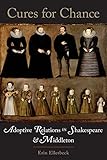Cures for Chance : Adoptive Relations in Shakespeare and Middleton / Erin Ellerbeck.
Material type: TextPublisher: Toronto : University of Toronto Press, [2021]Copyright date: 2021Description: 1 online resource (184 p.)Content type:
TextPublisher: Toronto : University of Toronto Press, [2021]Copyright date: 2021Description: 1 online resource (184 p.)Content type: - 9781487508784
- 9781487538965
- Adoption in literature
- English drama -- Early modern and Elizabethan, 1500-1600 -- History and criticism
- Families in literature
- LITERARY CRITICISM / Modern / 16th Century
- A Chaste Maid in Cheapside
- Middleton
- Renaissance drama
- Shakespeare
- Titus Andronicus
- Women Beware Women
- adoption
- alteration of nature
- cultivation
- early modern literature
- family
- reproduction
- theatre
- 822.3/3 23
- PR3069.F35 E45 2022
- online - DeGruyter
| Item type | Current library | Call number | URL | Status | Notes | Barcode | |
|---|---|---|---|---|---|---|---|
 eBook
eBook
|
Biblioteca "Angelicum" Pont. Univ. S.Tommaso d'Aquino Nuvola online | online - DeGruyter (Browse shelf(Opens below)) | Online access | Not for loan (Accesso limitato) | Accesso per gli utenti autorizzati / Access for authorized users | (dgr)9781487538965 |
Frontmatter -- Contents -- Acknowledgments -- Introduction: Shaping the Family -- Chapter One. Shakespeare’s Adopted Children and the Language of Horticulture -- Chapter Two. Animal Parenting in Shakespeare’s Titus Andronicus -- Chapter Three. Middleton’s A Chaste Maid in Cheapside and Adopted Bastards -- Chapter Four. Adoptive Names in Middleton’s Women Beware Women -- Afterword: In loco parentis -- Notes -- Bibliography -- Index
restricted access online access with authorization star
http://purl.org/coar/access_right/c_16ec
Adoption allows families to modify, either overtly or covertly, what is considered to be the natural order. Cures for Chance explores how early modern English theatre questioned the inevitability of the biological family and proposed new models of familial structure, financial inheritance, and gendered familial authority. Because the practice of adoption circumvents sexual reproduction, its portrayal obliges audiences to reconsider ideas of nature and kinship. This study elucidates the ways in which adoptive familial relations were defined, described, and envisioned on stage, particularly in the works of Shakespeare and Middleton. In the plays in question, families and individual characters create, alter, and manage familial relations. Throughout Cures for Chance, adoption is considered in the broader socioeconomic and political climate of the period. Literary works and a wide range of other early modern texts – including treatises on horticulture and natural history and household and conduct manuals – are analysed in their historical and cultural contexts. Erin Ellerbeck argues that dramatic representations of adoption test conventional notions of family by rendering the family unit a social construction rather than a biological certainty, and that in doing so, they evoke the alteration of nature by human hands that was already pervasive at the time.
Mode of access: Internet via World Wide Web.
In English.
Description based on online resource; title from PDF title page (publisher's Web site, viewed 19. Oct 2024)


